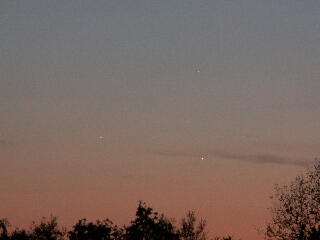Triple Conjunction, May 2013
Again glossing over the fact that they should actually be called "triple massings", conjunctions of three planets are, as mentioned in the introduction to the main page, fairly uncommon. There were actually two in May 2011 (Mercury-Venus-Jupiter and Mercury-Venus-Mars) and one (Mercury-Venus-Saturn) in August 2008 but all were so low down at dawn/sunset as to be effectively unobservable from here. The one before that (Mercury-Mars-Jupiter in December 2006) is shown on the main page. It was thus with great anticipation that I looked forward to that in May 2013, as it would not only be at dusk rather than dawn (not my best time of day!) but also reasonably high in the sky - 10deg at sunset.
Anticipation is always tempered by the British weather of course but having been generally overcast during the previous week the sky was, remarkably and unexpectedly, almost completely clear on the evening of closest approach (26th May), allowing me to get some excellent shots. Having picked up Venus in binoculars not long after sunset I was eventually able to find Jupiter and then Mercury as the sky slowly darkened. By the time Venus began to disappear behind a bush about half an hour later I could just about see all three naked-eye, but it was never going to be a great visual spectacle!
There was a bit more cloud on the horizon the next day, but not so much as to prevent me getting a further sequence of pictures (or from pointing out the planets to a rather bemused dog-walker who just happened to be passing!). My luck ran out on the 28th, when Venus and Jupiter were at their closest (1 degree), but I wasn't too worried about that.
| | | |
 | Here we have the view on 26th May, with Jupiter on the left, Venus on the right and Mercury above in a nice triangle. The separations are Jupiter-Venus 21/4 degrees; Jupiter-Mercury 21/2 degrees and Mercury-Venus 13/4 degrees. |
 |
| Just a day later everything has changed. Venus and, particularly, Mercury move so quickly across the sky that the shape of the triangle is now quite different. The separations are Jupiter-Venus 11/3 degrees; Jupiter-Mercury 21/2 degrees and Mercury-Venus 21/4 degrees. This image was taken less than seven minutes before the one above, but the difference in sky colour and brightness is quite striking. This is partly because the planets are so close to the horizon that a few minutes movement changes their elevation considerably - Venus is 41/4 degrees above the horizon in the image taken on 26th but 51/4 degrees in this one: almost 25% higher. |  |
 | To illustrate the movement of Mercury and Venus I made a composite image from close-up views taken on 26th and 27th, aligned on Jupiter (assumed to be unmoving), and from it constructed the series of frames shown on the left: click or tap to move forward through the sequence. The first frame is the position on 26th, the second that on the 27th, the third shows both situations combined, and the last shows the combination view labelled up. It is clear that Mercury has moved much more than Venus, as might be expected.
[Note that these frames are not to "standard scale"] |
| | | |
The next clear night was 31st May, when I noticed that Mercury, Venus and Jupiter would lie almost exactly in a straight line (though rather far apart). Low cloud made finding Jupiter difficult, but I managed to get a couple of shots just as it disappeared into a cloud-bank. Venus is clearly visible to top left while Jupiter is central, about 1/3 way up from the bottom. Unfortunately, these shots did not include Mercury and so I had to wait, hoping Jupiter would re-appear below the cloud-band before it set. |  |
 | Miraculously, not only did it do so but I also managed to capture it with the camera - including Mercury this time! If you're having trouble finding Jupiter, it's almost in the centre of the very lowest patch of pink sky. Venus is about in the middle of the picture, with Mercury to top left. The separations are Mercury-Venus 33/4 degrees and Venus-Jupiter 31/4 degrees. These pictures are again to "standard scale", so this one needs to be rather larger than those above in order to get all three planets in. |
And that was it really. The "triple grouping" of October 2015, though photogenic, was not actually a conjunction by my criterion so I had to wait until 10th January 2021 for the next event, when Mercury, Jupiter and Saturn got together in a very similar pattern to that above. The massing turned out to be impossible to observe in practice though, as it was just 6 deg high at a 4pm sunset (compared to 10deg for the 2013 event) and Saturn was very faint (just magnitude 0.6) and thus hard to see in the twilight. Things don't get any better for a long while unfortunately, because the next three triples after that (the Mercury-Mars-Saturn events of 20th April 2026, 2nd June 2032 and 22nd July 2036) are also just 6 deg high at sunrise/set (though the 2032 event does include Uranus, to make it a sort of "quad"). I was very happy to have made the most of the 2013 event, therefore!






